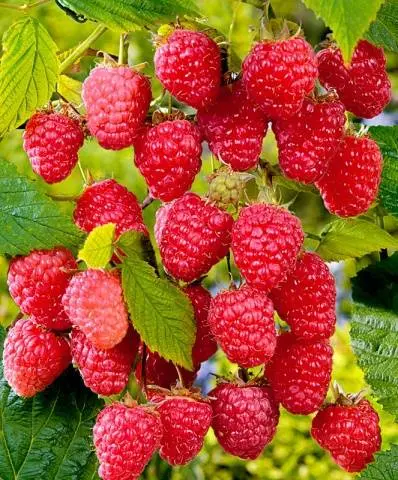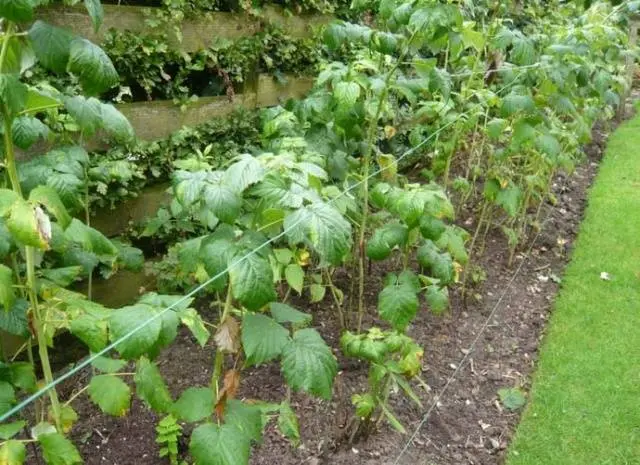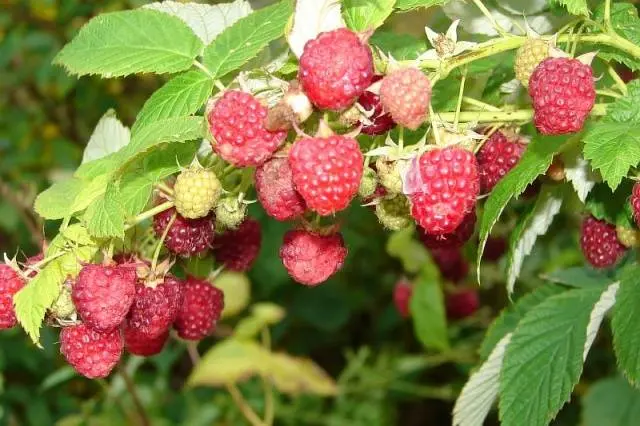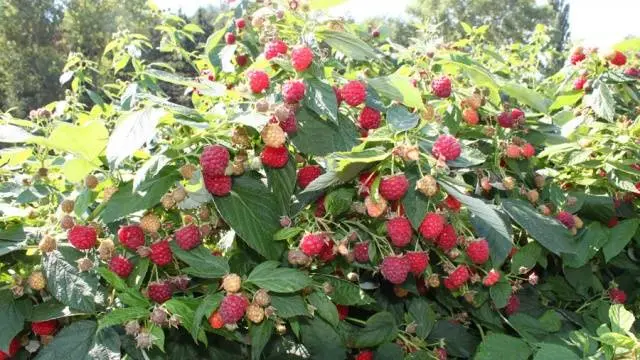Contents
Raspberry August miracle is one of the earliest remontant varieties. It is grown by farms and gardeners on their plots. The variety is characterized by large sweet berries that ripen before autumn frosts. Raspberries of the August miracle variety are chosen to obtain a stable autumn harvest.
Characteristic of the variety
Description of raspberry variety August miracle:
- remontant variety;
- height from 1 to 1,4 m;
- compact size of raspberries;
- standard type of bush;
- the presence of spikes;
- berries ripen ½ of the length of the shoots.
Characteristics of the berries of the August miracle variety:
- elongated conical shape;
- large size;
- average weight 8 g;
- sweet taste;
- pronounced raspberry aroma.
The August miracle variety stands out for its high yield. Each bush brings 4-6 kg of fruit. Berries are used for fresh consumption, freezing for the winter, making drinks and desserts. In home canning, jam and compotes are made from raspberries.
Berry ripening begins in August. Depending on climatic conditions, fruiting may shift. Harvest before frost.
Planting raspberries
Raspberry of the August miracle variety is demanding on the place of cultivation. Plants are planted in the prepared area. For propagation, they use their own seedlings or purchase planting material in nurseries.
Breeding varieties
According to the description of the variety, photos and reviews, the August miracle raspberry produces many shoots that can be used for propagation.

Ways to get raspberry seedlings:
- Cuttings. In autumn, they dig up a raspberry root and divide it into segments 10 cm long. The resulting planting material is planted in trenches, covered with earth and moisture is added. In spring and summer, seedlings are watered, and seated in autumn.
- Root cuttings. Most root shoots appear in bushes older than 4 years. When the shoots grow to 10 cm, they are transplanted to a separate bed, watered regularly, darkened from sunlight and mulched with humus. When the raspberry takes root, it is planted in a permanent place.
Ready-made seedlings of the August miracle variety are purchased from trusted suppliers. Plants should be 20 cm long and shoots 5 mm in diameter. In healthy raspberry seedlings, the root system is developed, not overdried and without damage.
Site Selection
Raspberries prefer areas with fertile light soil and constant lighting. When planting in the shade, yields are lost, fruiting dates are shifted, and the berries lose their taste.
Best of all, raspberries develop on loam, which passes moisture well. Coarse river sand is introduced into heavy clay soil. Sandy soils are fertilized with humus or peat.
Too acidic soils are not suitable for growing raspberries. The addition of lime and dolomite will help improve their composition.
Before planting raspberries, the site is dug up and rye, lupins or other green manure are planted on it. They are embedded in the ground a month before planting the main crop. Instead of green manure, per 1 m2 use 2 buckets of humus and 300 g of complex fertilizer containing potassium and phosphorus.
It is best to place the raspberry on a hill. In the lowlands, plants are exposed to moisture and cold air.

Order of work
Remontant raspberries are planted in spring or October after leaf fall. The soil begins to prepare in advance. It is better to leave the landing pit for 2-3 weeks and wait for the soil to settle.
Sequence of work:
- Planting pits 40×40 cm in size are prepared for raspberries. 70 cm are left between them.
- The day before planting, the roots of the seedling are placed in a root formation stimulator.
- An earthen mound is poured into the pit, a plant is placed on top. The root neck of the raspberry is left at ground level.
- The roots of the plant are covered with soil, which is well tamped.
- 3 liters of water are added under the raspberry bush.
Young plants are watered every week. Mulching with peat or humus helps keep the soil moist longer.
Variety care
To obtain a high yield of raspberries, the August miracle provides the necessary care. Plantings are watered and fertilized. In autumn, pruning of shoots is performed. Additionally, plantings are treated with special preparations for diseases and pests.
Watering
Repair raspberries are watered weekly. The soil should get wet to a depth of 30 cm. In drought, watering intensity is increased up to 2 times a week. It is necessary to ensure that the soil does not dry out and remains slightly moist.
Only warm water is suitable for watering raspberries. Exposure to cold water from a hose is stressful for plants and slows down their development. Moisture is applied in the morning or evening.
After watering, raspberries loosen the soil so that moisture does not stagnate and is absorbed faster. Loosening promotes air exchange in the soil, as a result of which raspberries absorb nutrients better. In late autumn, the last watering of raspberries is performed to avoid freezing of the soil in winter.
Feeding
To ensure extended fruiting of raspberries, the August miracle is helped by regular top dressing. Due to the application of fertilizers during planting, the plant is provided with nutrients for 2-3 years. In the future, top dressing is carried out annually.

After the snow melts, nitrogen fertilizers are applied to the soil to help the raspberries grow shoots. For top dressing, they take slurry or an infusion of bird droppings at a concentration of 1:15. Landings are watered under the root.
Before flowering, raspberry feeding is repeated with the addition of 30 g of superphosphate and 20 g of potassium salt per 10 l of fertilizer.
In the future, the August miracle raspberries are fed only with phosphorus and potassium substances. They are introduced into the soil at the beginning of the ripening of berries and during mass fruiting.
In autumn, after picking berries, the soil in the raspberries is dug up and fertilized with wood ash. Due to the fertilizer, the plants are saturated with potassium, calcium and magnesium.
Trimming
In late autumn, remontant raspberries, the August miracle, are cut at the root. This method of processing ensures high yields for the next year. It also reduces the risk of the spread of diseases and pests that choose raspberry shoots for wintering.
If you leave the bushes for the winter, then in the spring you need to cut out frozen and dry branches. The procedure is carried out when the kidneys swell to reveal healthy raspberry shoots.
At 1 m2 landings leave 10-15 shoots. The rest of the branches are cut to avoid thickening, or used to propagate the variety.
Protection against diseases and pests
According to reviews, raspberry August miracle has an increased resistance to diseases. With high humidity and lack of care, plants suffer from fungal diseases. A gray bloom or brown spots appear on the shoots.
To protect raspberries from fungal diseases, fungicides Oxyhom, Fitosporin, Fundazol are used. The preparations are diluted with water, after which the plants are sprayed. The procedure is carried out 3-4 times during the season.

Raspberries attract ticks, weevils, aphids, caterpillars and other pests. Against insects, Actellik or Karbofos preparations are used. Processing is carried out before flowering and in the fall after harvesting.
When flowering and fruiting raspberries, insecticides are used with caution. Most of them are limited in use.
Then resort to folk remedies. During the growing season, raspberries are treated with a solution containing wood ash. To repel pests, infusions are also prepared on onion peel, garlic or tansy.
Reviews of gardeners
Conclusion

Raspberry August miracle is characterized by high yield, large fruits, resistance to cold snaps and diseases. The condition for a good crop crop is regular care. Raspberries are watered, fertilized with natural means and mineral complexes. For the winter, the shoots are pruned, which contributes to increased fruiting the next year.









